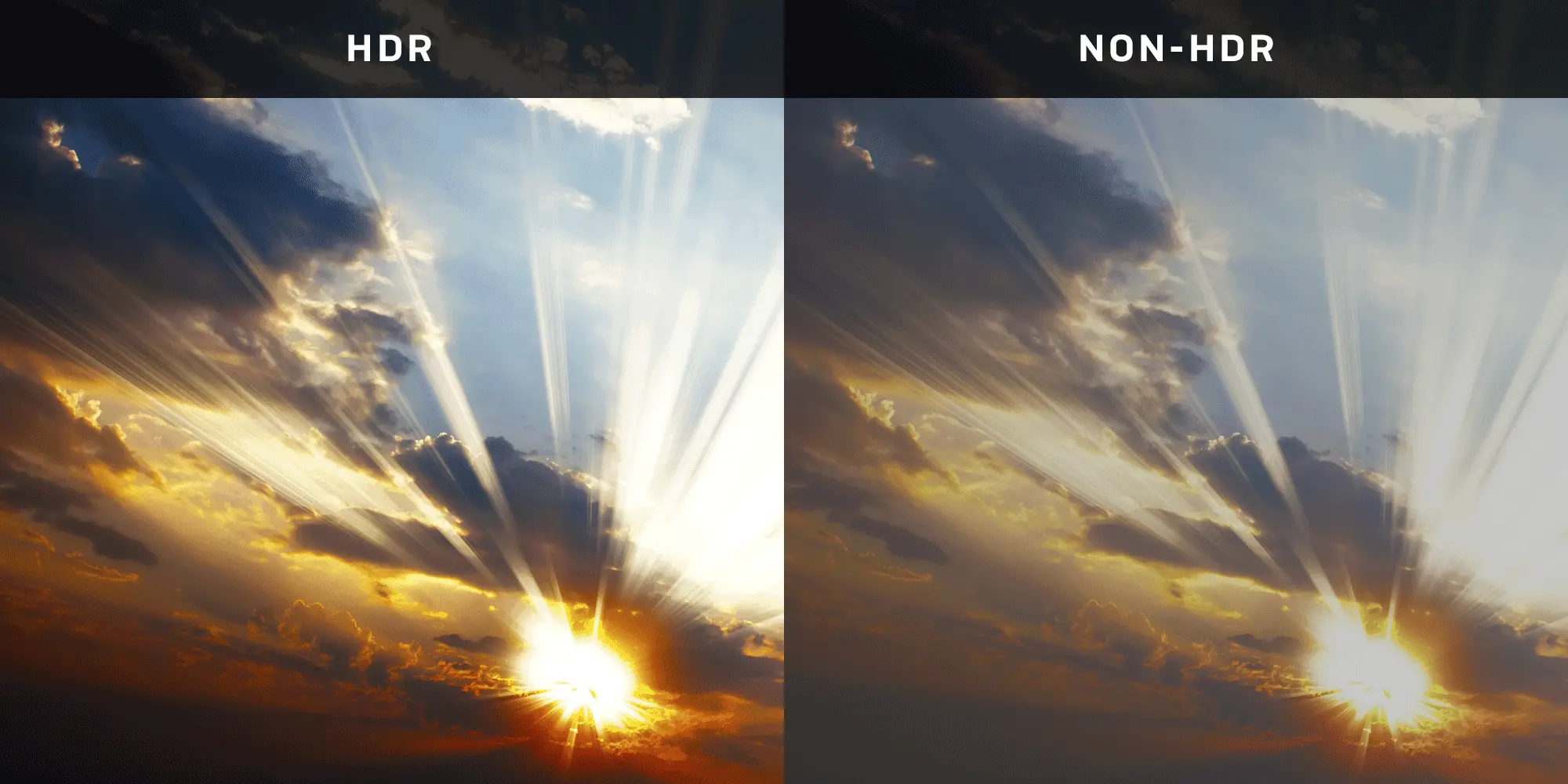HDCR has been on MSI monitors for years. In the monitor space, ‘high dynamic contrast range’ is a feature that boosts visibility compared to a standard picture mode, with a stronger difference between the darkest and lightest areas delivering an image where shadows appear brighter and details stand out more clearly.
HDCR is used mostly on MSI gaming monitors, but that doesn’t mean it works like HDR. That’s where the comparison of hdcr vs hdr becomes important.
What Does HDCR Mean on Monitors?
The hdcr meaning monitor is High Dynamic Contrast Range, and it is an MSI technology that can be turned on through the hdcr monitor setting in the on-screen display or with MSI software. Once enabled, the hdcr monitor setting adjusts contrast in real time to brighten darker scenes, making it easier to see players, objects and menus that would normally blend into the background.

HDCR does not need an HDR panel or certification to function. Instead, the hdcr monitor setting works even on displays without HDR hardware, giving MSI users a way to improve clarity in games without upgrading to a more expensive hdr monitor. This makes it especially popular in competitive play, where visibility in shadows can decide the outcome of a round.
What Is HDR on Monitors?
HDR has been part of display technology for a long time now. In the monitor space, the hdr meaning display is ‘high dynamic range’ and it refers to a standard that allows an hdr monitor to show a much wider difference between the brightest and darkest areas on the screen, which creates an image that feels more realistic and closer to what the human eye naturally sees. Where a standard picture mode keeps colors and brightness locked within a smaller range, the hdr meaning display expands the whole spectrum, delivering more vibrant colors, deeper blacks, and highlights that look brighter without washing out detail.

The hdr monitor is available in different levels, because not all HDR support is the same. HDR10 is the most common and is considered the baseline, and every hdr monitor that is certified will support it, but higher standards like DisplayHDR400, DisplayHDR600 and DisplayHDR1000 show how capable a panel really is in terms of brightness, color and contrast. An hdr monitor with higher certification can hit greater brightness levels and maintain more detail in highlights, which makes games, movies and videos appear more immersive. This is why the hdr meaning display is tied to industry certifications, because only monitors that can achieve these levels of performance are considered true HDR.
Key Differences Between HDCR vs HDR
The hdcr vs hdr comparison shows two very different approaches to image quality. HDCR is an MSI-specific feature that works on monitors without HDR hardware, while HDR is a global VESA standard that defines what an hdr monitor must deliver in order to be certified. In other words, hdcr vs hdr is not a choice between equal technologies, but a difference between a proprietary software setting and an international display format.
Looking at hdr vs hdcr from a purpose perspective also makes the split clear. HDCR is about boosting visibility by lifting shadow detail and dynamically adjusting contrast in darker scenes, while HDR is about recreating a full cinematic picture by expanding brightness, colors and contrast across the entire panel. The hdcr vs hdr feature table often points this out: HDCR helps with shadows in games, HDR helps with everything from highlights in bright skies to subtle details in dark environments.
| Feature | HDCR | HDR |
|---|---|---|
| Origin | MSI monitor feature | Industry standard |
| Purpose | Boosts contrast dynamically | Expands brightness, colors & contrast |
| Hardware | Works on non-HDR panels | Requires HDR-capable panel |
| Visual effect | Helps visibility in dark scenes | Realistic highlights & color depth |
In terms of support, hdcr vs hdr is also very different. HDCR works only on MSI monitors and does not require specific panel hardware, while HDR requires an hdr monitor that is capable of producing a certain brightness level and color depth. This means hdr vs hdcr is not just about naming — HDR is the broader industry technology that has become a standard across PC gaming, consoles and streaming, while HDCR is a tool that helps users of MSI monitors who do not have HDR support still get a clearer image in competitive situations.
So when players ask about hdcr vs hdr, the answer is straightforward: HDR is the standard that transforms visuals across the board, and HDCR is a useful MSI option that improves contrast locally. HDR vs HDCR shows one is global and hardware-based, while the other is brand-specific and software-driven.
Gaming Impact – HDCR vs HDR
When you look at the hdcr gaming monitor the purpose is clear, because this feature was designed for competitive play where visibility in dark maps can change the outcome of a round, and the hdcr gaming monitor makes that possible by lifting the brightness in shadowed areas so that opponents hiding in corners or moving through darker rooms are easier to notice, which gives players more time to react. This makes the hdcr gaming monitor valuable in eSports and fast FPS titles where clarity matters more than overall cinematic detail, and it works even if the panel does not have HDR support.

The hdr gaming experience is different, because it is not about one software trick but about an entire panel standard that transforms the image across every part of the screen. On an HDR display, the hdr gaming experience means bright lights look real, colors look richer, and the contrast between the darkest parts and the brightest highlights feels much more natural, which adds to immersion in story-driven RPGs, open-world games and modern AAA blockbusters. Players who want cinematic depth and realistic lighting will prefer the hdr gaming experience, while those focused on fast response in competitive play may still find the hdcr gaming monitor more practical.
Which One Should You Use?
If your display supports HDR, then HDR is the clear choice, because HDR adds depth to movies, games and any visual content that benefits from expanded brightness, wide color gamut and high contrast, and the hdr monitor will give you a better overall experience when the content is designed for it.
If your monitor does not support HDR, the hdcr monitor setting still has value, because HDCR can provide an improvement in visibility on MSI monitors that lack HDR hardware. For players who focus on shooters or competitive games, turning on HDCR can be the difference between spotting an enemy in the shadows and missing them completely.
So the choice depends on the panel: HDR if you have the hardware, HDCR if you do not.
Final Verdict: HDCR vs HDR
The conclusion of hdcr vs hdr is that HDR is the technology that sets the standard across the industry, with certified hdr monitor models offering brightness, contrast and colors that transform how modern games and media look, while HDCR is a specific MSI feature that works on non-HDR panels by boosting contrast to improve visibility in shadows.
For players who want the cinematic hdr gaming experience, HDR is the best choice, but for those with MSI monitors that do not support HDR, the hdcr monitor setting still provides a practical advantage in competitive play. HDR is the future of displays, while HDCR is a useful option when HDR is not available.
FAQs About HDCR and HDR
Does HDCR improve image quality?
HDCR improves visibility by lifting dark areas, but it does not expand brightness and color in the same way HDR does.
Is HDCR the same as HDR?
No, hdcr vs hdr shows they are different. HDCR is an MSI feature that boosts contrast, while HDR is a global industry standard supported by hdr monitor hardware.
Can I use HDCR and HDR together?
No, they are separate functions. The hdcr monitor setting is a software tool on MSI monitors, and HDR is a hardware standard. They are not designed to run at the same time.